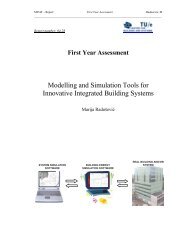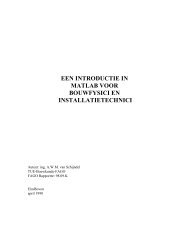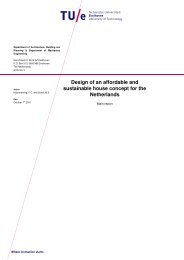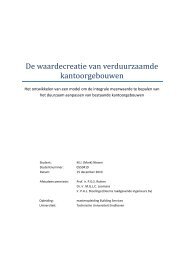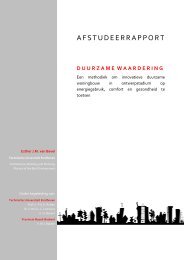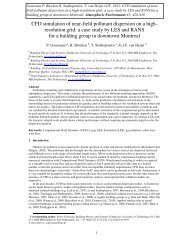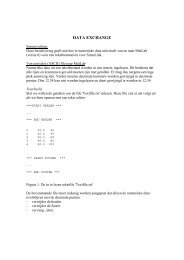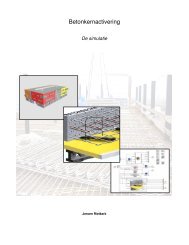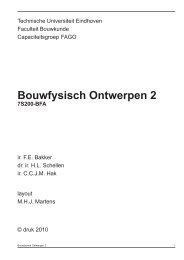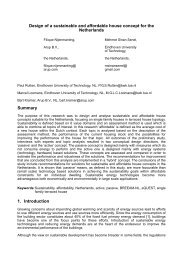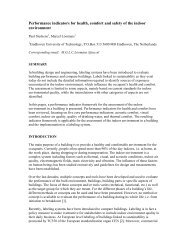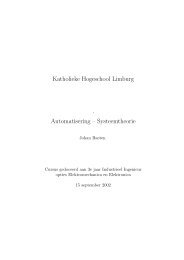Title of Contribution to ROOMVENT 2004
Title of Contribution to ROOMVENT 2004
Title of Contribution to ROOMVENT 2004
Create successful ePaper yourself
Turn your PDF publications into a flip-book with our unique Google optimized e-Paper software.
sheet. The sheet is heated and then radiates <strong>to</strong> thewooden floorboard and the people’s feet that areplaced beneath the kneeler pad.Figure 1. Heating elements applied in the pew2.1 Seat heating elementBack heatingSeat heatingKneeler PadheatingThe heating element that is applied under the seatis a semicircular element, with heating foil as the heatsource, which is designed <strong>to</strong> radiate heat <strong>to</strong> people’slegs. In order <strong>to</strong> prevent overheating the seat, whichcan cause the wood <strong>to</strong> crack, insulation is appliedbehind the heating foil. So the heat is only radiated <strong>to</strong>the wooden floorboard and <strong>to</strong> the front and back <strong>of</strong>the pew. In order <strong>to</strong> protect the heating foil, it iscovered with a perforated metal grid that is kept at adistance <strong>of</strong> 1 cm from the foil with help <strong>of</strong> spacers.The perforation rate <strong>of</strong> the metal grid is 50% so the IRradiation from the heating foil can reach the peopledirectly.In one pew, two <strong>of</strong> these heating elements areapplied, each with an electrical load <strong>of</strong> 155W. Thespecifications are presented in table 1.2.3 Back heating elementIn the back heating element, the heating foil iscovered on both sides (back and front) with theperforated metal grid that is mentioned before. Themetal grid in this heating element is also kept at adistance <strong>of</strong> 1 cm from the foil using spacers. Theheating element is attached between the back and theseat; in fact it closes the back <strong>of</strong> the pew.In each pew, one back heating element is appliedwith an electrical load <strong>of</strong> 370W.3 Climate room set-upThe measurements discussed in this paper wereused as input parameters for the boundary conditions<strong>of</strong> the CFD model. Secondly, these results will beused for the verification <strong>of</strong> the simulation results.Eventually, the heating system that will be used in thechurch pews will consist <strong>of</strong> a combination <strong>of</strong> heatingelements. But <strong>to</strong> study the effects <strong>of</strong> each heatingelement on its environment, all measurements wereperformed on one type <strong>of</strong> heating element in a steadystate indoor environment. This environment wascomposed in the climate chamber <strong>of</strong> the EindhovenUniversity <strong>of</strong> Technology.2.2 Kneeler pad elementThe heating element that is applied beneath thekneeler pad consists <strong>of</strong> a resistance wire (RaychemElectromelt EM2-R) that is double folded. Theresistance <strong>of</strong> the wire increases when the temperature<strong>of</strong> the wire increases. Therefore the wire has a peakload <strong>of</strong> 970W right after switching on the power anddecreases <strong>to</strong> 130W when the equilibrium temperatureis reached after about 3 minutes. To preven<strong>to</strong>verheating the kneeler pad, which can damage thewood, insulation is applied between the electricalresistance wire and the kneeler pad. This combination<strong>of</strong> insulation and heating wire is covered with a metalFigure 2. Overview <strong>of</strong> climate room with the benchesTable 1. Overview <strong>of</strong> the heating systemsHeatingelementShape Protective cover <strong>of</strong>the elementHeat sourceseat semicircular metal grid,50% openback rectangular metal grid,50% openKneeler rectangular metal sheet Electricalpadresistance wireLength[m]Width[m]Height[m]ElectricalPower[W]#per pewElectrical foil 0.99 Radius = 0.11 155 2Electrical foil 2.00 0.02 0.35 370 12.00 0.09 0.02 130(start peak 970W)1



